
Rhiwlas – A Mountain Apart
Research into how Livestock Grazing Behaviour effects Habitat Health in Upland Wales.
by Georgia Wingfield-Hayes
Rhiwlas Estate is tucked away on the far eastern edge of Snowdonia National Park in Wales. A hill farm where sheep, accompanied by a few cattle, graze 800 hectares of open mountain moor throughout the summer months.
For many years owners Richard and Flora Price have worked with local authorities through environmental enhancement schemes to try and fully restore the health and well-being of this complex mountain ecosystem. No less because the estate lies within the Migneint-Arenig-Dduallt Site of Special Scientific Interest (SSSI), Special Area of Conservation (SAC) and Special Protection Area (SPA).
The moor is of European significance for breeding populations of Hen Harrier and Merlin. It is also of particular interest for Short-eared Owl, Peregrine Falcon, Black and Red Grouse, Ring Ouzel and Golden Plover. Along with other species, almost all these birds nest on the ground and require specific conditions for nesting, hunting and foraging for food.
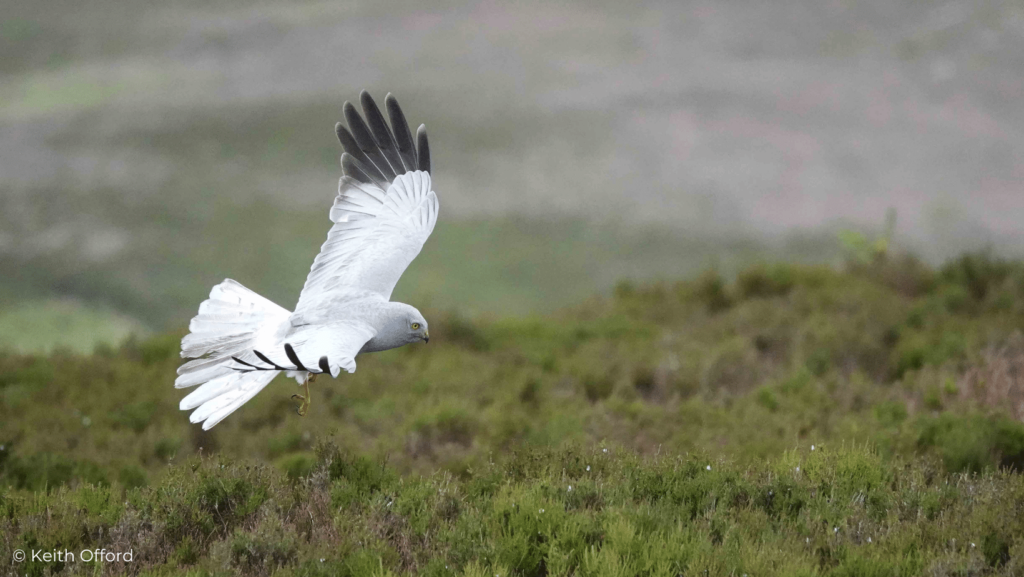
Male Hen Harrier
Working alongside local conservation organisations and government bodies, in particular, Natural Resources Wales (NRW), Richard and Flora have come to have a deep appreciation for the wildlife that live on their estate and want to do all they can to reverse the species decline that has been seen nationally in the last 50-60 years.
The Mountain
The mountain is composed of a mosaic of five different habitat types typical to this part of Wales. 1. Dry Heath – made up of Heathers, Bilberry and other small shrubs. 2. Blanket Bog – wet peatland with Sphagnum Moss, Purple-moor and Cotton Grass. 3. Flush – wet areas where waters flow, with thickets of Purple-moor Grass where Snipe feed. 4. Bracken, which grows tall giving little else a chance to grow, and 5. Acid grassland with a rich mix of grasses and herbs, which the sheep tend to favour over other habitats for grazing.

Mosaic of Habitats, Rhiwlas
In recent decades some say that the moors have turned silent, the rich mix of bird species that once occupied the mountains having greatly reduced. Scientists recognise that the bio-phonics of an ecosystem is a very good indication of its overall health, but the reasons why these ecosystems have declined in biodiversity are not so easy to fathom. They are complex and most likely the result of multiple factors.
Some of these factors, speaking in general terms across the British uplands over the last 50-60, include: stocking densities; the use of pesticides and herbicides on land and animals (externally and internally); the management of moors for Grouse shooting; climate change; heath management – burning and cutting; and predation of bird’s nests, in particular by Foxes and Carrion Crows.
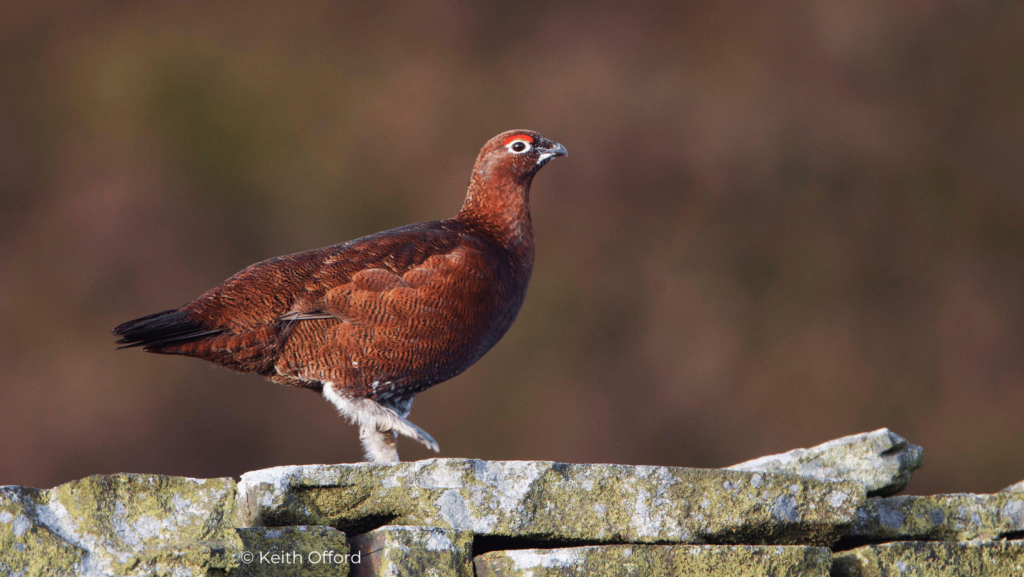
Red Grouse
Over the years, conservation organisations and government bodies have changed management requirements in attempts to improve habitats. These have included both decreasing and increasing stocking rates, stopping burning and cutting and then encouraging it once more. Together, we are all learning what optimal management really looks like. But we’re not there yet. In the NRW’s assessment of Rhiwlas carried out in 2020, it found that 74% of habitats were still in an unfavourable condition.
These unfavourable conditions are varied and complex, for example, some areas are under-grazed while others are over-grazed. So we begin to see that making decisions about the management of upland landscapes is by no means straightforward.
In 2020 Rhiwlas went into a farmer-led Environmental Management Scheme to carry out work to improve the habitat conditions on the mountain. Flora and Richard, who also share-farm a regenerative dairy, started getting curious about grazing in the mountain and what effect that was having on habitat well-being. So they signed up for the Wilderculture basic training course where we teach about our approach.
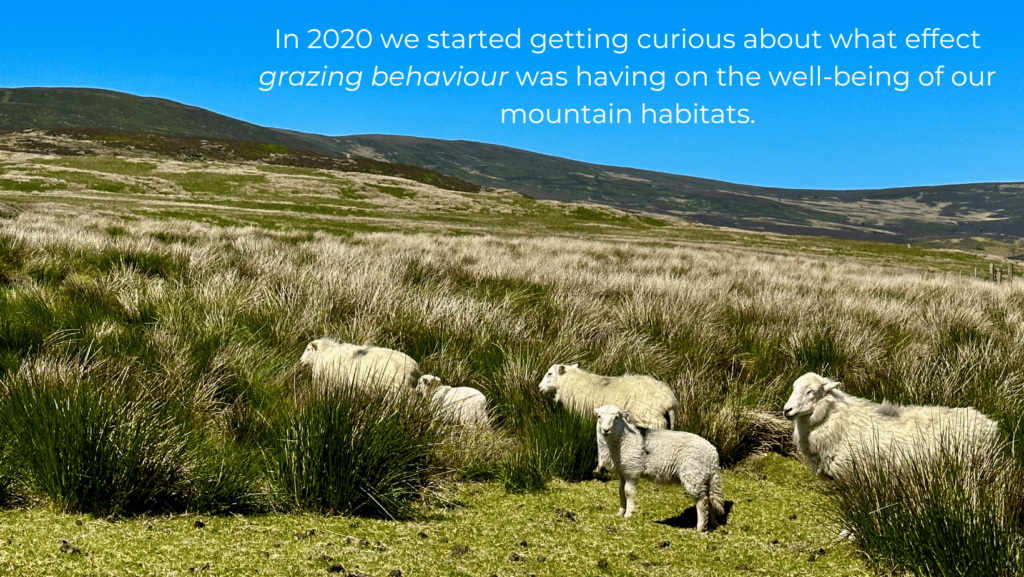
Rhiwlas sheep
One aspect of this training is the subject of the relative palatability of different plants and habitats. Different grazers have different preferences, with some being more selective than others. If livestock are allowed to choose, they will preferentially graze the higher palatability habitats and under-graze the unpalatable areas. This makes grazing planning in an upland mosaic very complex. Flora, who is a biologist by training, said, “I had a eureka moment when I realised that we hadn’t really been looking in any detail at what influence ruminants were having on the moorland ecosystem.” Previous focus had been on predator control and habitat management through burning and cutting, but the grazing of animals, up to that point, had only been looked at from the perspective of an overall stocking rate of the 800 hectares.
So with the support of the NRW and the direction of Caroline Grindrod of Wilderculture, a study was designed in order to try and figure out the what, when and why of livestock grazing on the moor. Miriam McDonald and Robert Owen of Holistic Restoration are the ones who have co-designed and carried out this study, which has now been ongoing for the last year and a half.
With the aid of GPS collars on animals, camera traps and bio-phone recordings in each of the five habitats, the team are discovering that things are even more complex than anyone had first imagined!
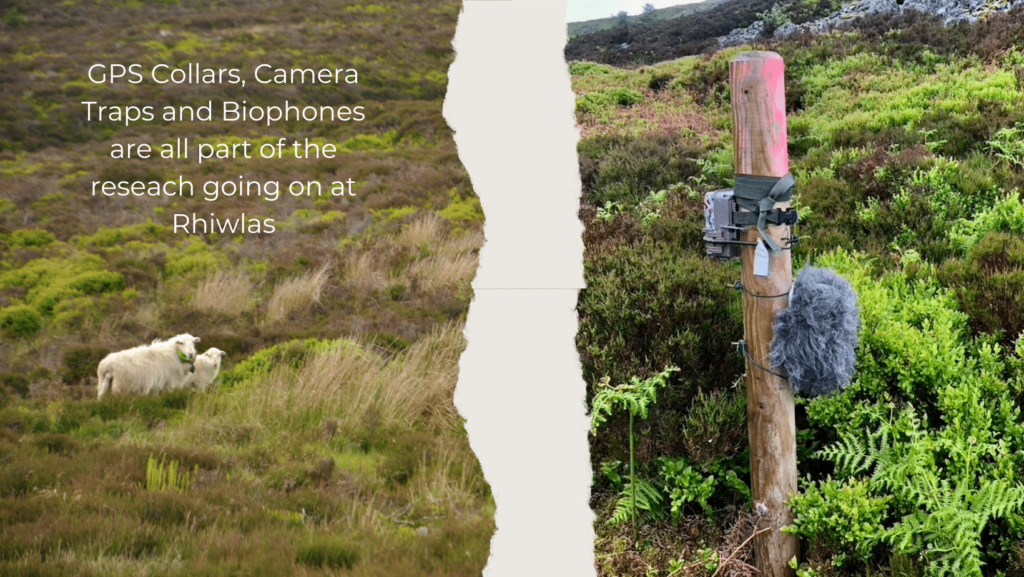
Biophones and camera trap, Rhiwlas
Stocking Rates
In all upland areas with SSSI’s SAC’s and SPA’s, local authorities work with farmers to decide the best stocking rates to support habitat restoration. In Wales, this body is the NRW. They work with national guidelines, which provide rates for each of the habitat types on the mountain. These rates, multiplied by the number of hectares of each habitat, are then added together to give an overall stocking rate for the estate. On blanket bog, for example, the rate is 0.33 sheep per hectare. On acid grassland and bracken, it is 2.67 per hectare, on flush 1 and dry heath 1.5. This puts the overall recommended rate for the 800 hectares of mountain at around 1500 sheep, although this varies throughout the year. Currently, this is our best method to get stocking densities that support the well-being of habitats. However, how and where animals actually spend their time grazing is by no means a simple science.
The Art and Science of Shepherding & Relative Palatability
Fred Provenza is a North American writer, researcher and all-around expert on livestock foraging behaviour. What Fred shows us is that animal’s foraging needs vary greatly within a species; that animals, given a choice of forage sources, will go for the plants they need to balance out nutrients and detox compounds such as alkaloids, tannins and terpenes; that these compounds are medicinal and with knowledge, animals will eat these plants in order to self-medicate for internal parasites etc; but that animals need to learn how to utilise this wider variety of plants if they have not learned it from their mothers.
This is where the role of the shepherd becomes critical. Fred learned how shepherds in the mountains of France take animals to certain areas, for certain periods of time, in a certain order through the day, so that they are able to utilise plants that they would otherwise find unpalatable. The shepherd is simultaneously thinking about the overall nutritional needs of the sheep and the management of the habitats upon which they depend.
Fred gives a different example of a cattle herder in the USA who had always seen Sagebrush as a plant to be got rid of because the cattle find it unpalatable. Sagebrush is high in terpenes, but these reduce within the plant in winter, at which point it is possible for it to make up around 30% of the cattle’s diet.

Sagebrush North America
After hearing Fred talk, the rancher went home and tried these ideas. He went from seeing Sagebrush as a problem plant to seeing it as a forage source. He started herding the cattle within the Sagebrush in winter and consequently didn’t need to make as much hay as he had done before. Hay has become the complimentary food that the cattle needed to balance out the Sagebrush in their diet. The animals, while now enjoying this former ‘weed’, were meanwhile making space for other grasses and forbs to come through in the summer, bringing greater diversity back to the environment. In other areas, similar practices have seen positive outcomes for Sage Grouse populations as the health of the whole environment improves.
So let’s consider all of this new information in the context of upland Wales, where we have a complex mosaic of habitats, all of which are important in different ways and in different states for wild species. Now the question about forage impact broadens out from seeing what sheep like to eat, to considering the intergenerational nutritional wisdom within the herd and how shepherding might affect these dynamics and shift them towards more favourable management for the mountain ecosystem as a whole.
Learn about the project by watching the short documentary film below.
The Study So Far
Holistic Restoration is a small organisation created by the dynamic duo of Miriam McDonald and Rob Owen. Two people with a voracious curiosity about how to regenerate degraded ecosystems and innovative ideas about how to dig down and discover the root cause of the problem.
They have spent the last year and a half creating a bank of baseline data about how sheep behave on the moor at Rhiwlas. They shared with me some broad conclusions that have come out of the study so far. Firstly it is clear to observe that the sheep favour the acid grassland over all other habitats. They also use the flush quite a lot, especially in wet weather. The recommended stocking rates for acid grassland and Bracken are the same, but the sheep rarely graze in the Bracken. The dry heath is also under-grazed, although the sheep will go there at specific times of day, seemingly for specific things. One ewe and lamb, for example, went each day to the same place in the dry heath, to sit and rest a while.
Ornithologist Keith Offord has been carrying out bird surveys on the moor for the project. He has known these mountains his whole life, so is able to give us a unique, long-term perspective on the change in bird populations, albeit anecdotal. In his opinion, the three main factors that have caused the decline in species are: deterioration in habitat, climate change and predation, in particular by Foxes and Carrion Crows.
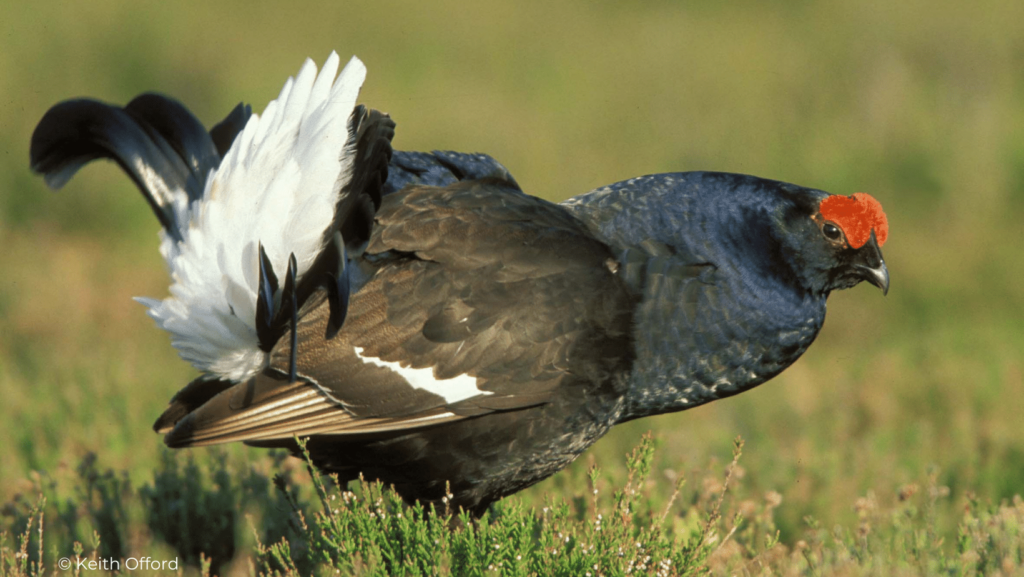
Black Grouse
Climate change is tending to push bird species further up in altitude in order for them to cope with higher temperatures. So Keith is seeing the unexpected, such as a Wren singing above 600m. It is generally accepted that climate change is likely to negatively affect upland species (Pearce-Higgins, British Birds 115 February 2022 62 – 66), especially those on the southern edge of their range. The observed decline in: Golden Plover, Ring Ouzel, Dunlin, Red Grouse, Black Grouse and Merlin at Rhiwlas, is consistent with this theory. This is further supported by population stability in species such as Hen Harrier, Cuckoo, Whinchat and Meadow Pipit whilst other species such as Willow Warbler, Whitethroat, Common Buzzard, Raven, Carrion Crow and Red Kite have clearly increased, for the same reasons.
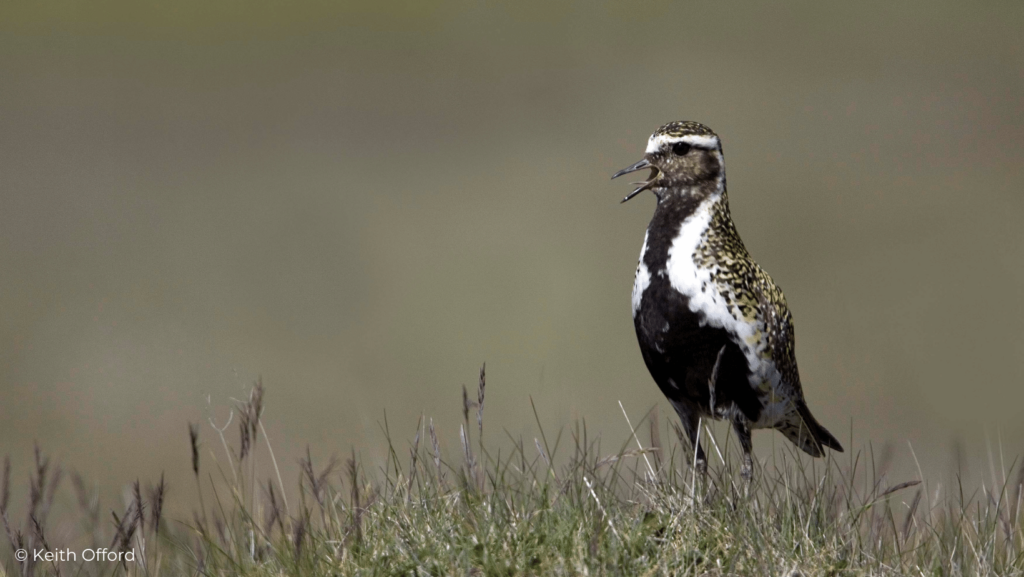
Golden Plover
In Keith’s opinion, the more varied the mosaic of habitats and the management thereof, the better, because different species have different needs. Hen Harriers, for example, will favour tall rank Heather to hide away and nest in. The Skylark, on the other hand, likes newly mown or burnt heather. A bit of everything seems to be the order of the day from the ornithological perspective.
Back to Shepherding
After the demise of the Wolf in Britain, shepherds no longer needed to protect their flocks from predators, but they still herded them to help them find the best forage throughout the day. Then, through centuries of enclosures acts, the ways in which we raise sheep changed until we eventually ended up with the systems of today. In the uplands in summer, this means sheep being largely left alone to graze their part of the mountain – their heft.
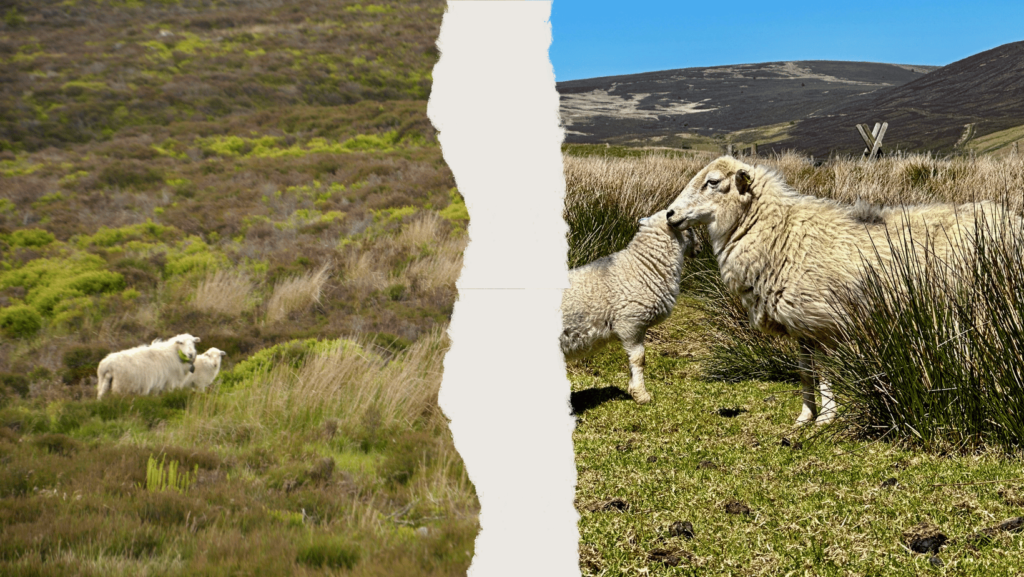
Sheep in different moorland habitats, Rhiwlas
On the Rhiwlas Estate, the ewes are taken up the mountain with their new lambs in May. The shepherds then go up, daily at first, to check the flock but also to push them up the moor because the sheep have a tendency to hang around the intake gate where the acid grassland is most prevalent. Driving them up the mountain encourages them to graze more of their heft.
Market prices for lamb are incredibly low, so sheep farming, as a business, is only really viable while subsidised. With changes afoot in farming policies following Brexit, the survival of these extensive grazing systems appears to be under threat, with payments in the uplands moving towards ecosystem services and away from food production. However, animal grazing is part of the management required to maintain these valuable mountain habitats. Not only can livestock help create dynamism in the system through grazing and trampling, but their faeces (as long as it is free of intestinal parasite treatments) is an essential font of insect life upon which many birds, bats and invertebrates feed.
With the knowledge that Fred Provenza has enlightened us with, perhaps rather than shepherding being a dying art, it is time for its renaissance. Are shepherds the key to sheep foraging in a way that is of most benefit, not just to livestock health and well-being but to the function of the whole ecosystem?
Whole-System Health
“The thing of whole-system health keeps coming up,” says Miriam as I press her on what the study is moving towards. “All of the interested parties have different things that are important to them, be it bird conservation, habitat health or the health and wellbeing of the livestock. But actually, all of these are about whole-system health. If we can work towards that, then we all win.”
So far the study has created an excellent bank of baseline data that we look forward to Miriam and Rob sharing with us in early June. What Flora, Richard, Caroline, Rob and Miriam are now really keen to understand is the complex, intergenerational relationships within the herd, the relationship between sheep and shepherd, and how all this affects the health of the mountain.
Are there ways in which these relationships could be augmented for the well-being of all? The team would like to try different methods of management and monitor the outcomes. So the hope is that more funding can be secured to explore this fascinating and complex landscape of how humans might act as a keystone species for the well-being of the land, wildlife, farming and the food we eat.
References
Fred Provenza @ GrassFed Exchange Part 1
https://www.youtube.com/watch?v=ncVJfZZ7bTM
Fred Provenza @ GrassFed Exchange Part 2
https://www.youtube.com/watch?v=rYXF0l18ciI


No Comments